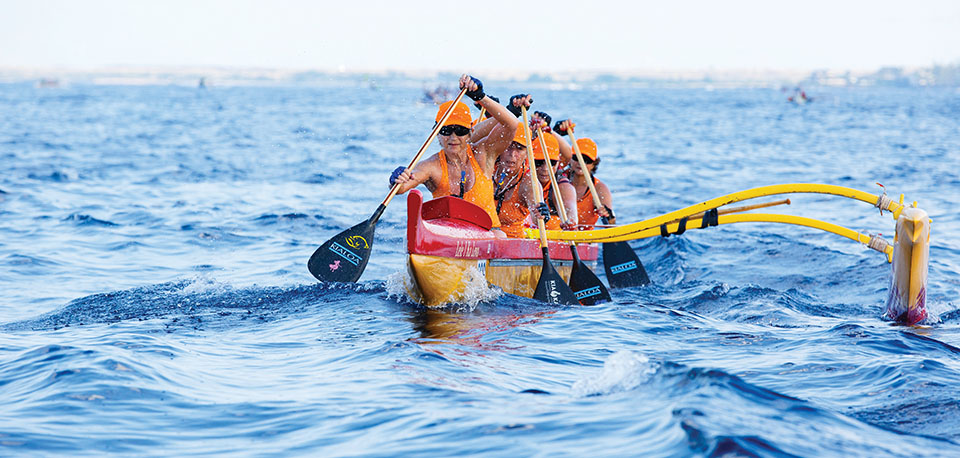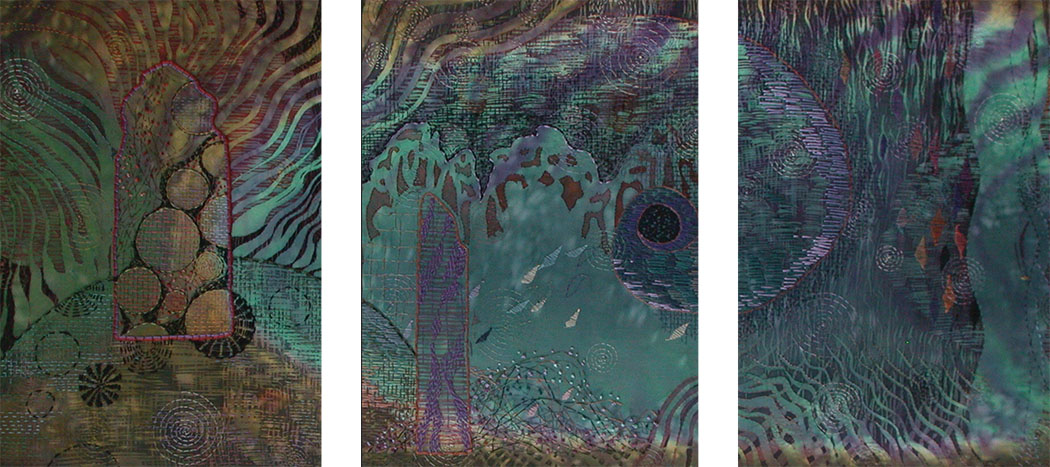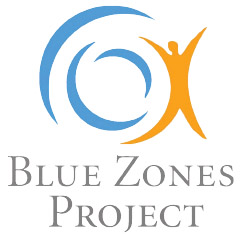
Blue Zones: How Hawai‘i Can Live Longer

 By Alan D. McNarie
By Alan D. McNarie
It’s a sunny, humid summer morning in North Hilo, and 30 or so people are gathered in the shade of a temporary tent shelter at the Kalalau Ranch, on the Hāmākua side of the Wailuku River, for a cooking and freshwater prawn-gathering demonstration. “Best time to go get prawns is night, in the flashlight, you can see their eyes shining,” Orion Enoncencio tells a group of would-be prawn-hunters, before they head down to the river in search of their quarry.
It’s probably best that these beginners are going down to the river by day, however, since the path is steep and slippery. They head out, past donkey and goose pens and three very contented-looking pigs lounging atop a huge compost pile, while the rest of the group starts chopping veggies to make a large lunch entirely of healthy, locally grown ingredients: tasty soup with bitter melon greens (which aren’t bitter, it turns out, if you know how to prepare them), a stir-fry dish with, among other ingredients, green peppers and kale (the apprentice cooks are instructed to carefully scrub all the wrinkles in the kale leaves to make sure there’s no slug slime, which can carry rat lungworm disease).
The prawn hunters return with a few specimens; they look like big shrimp, but with very long, skinny arms tipped with tiny claws. Along with others caught the night before, they’re added to a big stir-fry. Then everyone piles in to eat what they cooked.
This “farm to table” get-together, designed to promote a healthier lifestyle featuring tasty, locally grown food, is one of many events and programs sponsored around the island by Blue Zones Project Hawai‘i, the local branch of a nationwide movement.
How to be Healthy
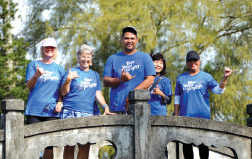
The goal of Blue Zones is to help people live longer and healthier lives. It is based on a book called The Blue Zones: Nine Lessons for Living Longer, by National Geographic Fellow Dan Buettner. Buettner led a team of scientists that identified areas around the world with high percentages of people who had lived over a century. The team analyzed what the people had in common in those areas, dubbed “Blue Zones” after the blue markers that the team used to circle such areas on the map. Buettner and his colleagues condensed those findings into nine “denominators” that the cultures in those areas had in common. People in Blue Zones, for instance, didn’t exercise for exercise’s sake; “natural movement,” such as walking or climbing stairs, was built into their lifestyles. They had “plant-based” diets—not necessarily meat-free, but based mostly on legumes, fruits and vegetables. Instead of gorging, they stopped eating when they felt about “80 percent full.” They also had clear purposes for their lives. (In an online TED Talk, Buettner noted that the two years of highest statistical mortality in the U.S. are the first year of birth and the first year of retirement.)
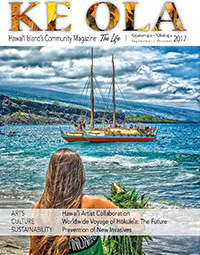
The centenarians are often members of “faith-based” communities. The longest-lived community in the U.S., Buettner found, was a group of Seventh-Day Adventists near Loma Linda, California. In these groups, it did not particularly matter what faith the communities practiced, however that faith had to foster a sense of purpose, a sense of belonging and a healthy lifestyle. Other groups, including family and friends, often supported their healthy lifestyles—the “right tribe,” as Buettner calls them. Buettner also points out the opposite can also be true: if your friends are obese, you’re likely to be, too.
Buettner’s book grew into a movement and attracted corporate sponsors such as HMSA, which brought the Blue Zones Project to Hawai‘i. The Project teams up with local governments, businesses, schools and organizations to encourage healthier lifestyles based on the Buettner team’s findings. Nowhere has that movement gotten a stronger foothold than on Hawai‘i Island, which has become the first entire county in the U.S. to become a Blue Zones Demonstration Zone. At a ceremony marking that milestone last winter, HMSA Chief Operations Officer Mike Stolla explained that while most health insurance companies wrote checks to people when they got sick, “We’re here to advance health, and that means advancing the issues and the things that really drive health…How we live, what we eat, our spiritual connections, our meaning in our lives—all these things have been shown really to advance health more than anything else.”
From Business to “Right Tribe”
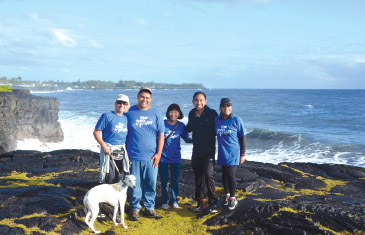
Lisa Cabalis oversees Hawai‘i Island’s Blue Zones team. Her background is in marketing and communications, she says, “But I’ve always been a little bit of a health nut. When I heard the Blue Zones Project would be in town, I knew it was something that I wanted to be a part of, whether I was going to be a volunteer or was lucky enough to be employed by the program.”
Her team works with local businesses, schools and other organizations, including nonprofits and churches, to adopt Blue Zones’ principles for their employees, students, members or parishioners. Each organization is presented with an “á la carte menu” of possible practices for achieving that aim. “The organization picks and chooses what works best for them,” says Lisa. “We know not every organization is the same, and as long as the organization meets a certain number of points, then they can become Blue Zones Project approved.”
About 186 organizations, including restaurants, grocery stores, other workplaces and faith-based organizations are currently participating in the project, and 30 or so have gained final approval for their programs.
The first to gain such certification was the Hawaii First Federal Credit Union. “We developed our own wellness program,” says Carrie Fernandez, HFFCU’s Innovation and Outreach Manager. The program is called “Wellth First.” Some of its elements were already in place when a Blue Zones employee, who was also a credit union member, told them about the project.
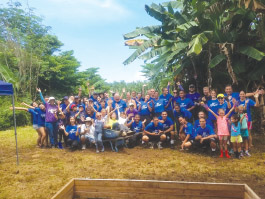
The credit union happily signed on board, and got its final approval within six months. Now its members enjoy such options as the “Babies to Work” program, which allows both men and women to bring their infants to work with them for the first six months of the babies’ lives. In addition to sick leave, employees get a “wellness day” for preventative medical appointments such as annual checkups. They participate in choosing healthy snacks such as smoothies or salads for work meetings. They get an allowance for health-related purchases such as running shoes, vitamins or gym fees. Every Wednesday is Wellth Wednesday, when employees come to work in casual shoes and sportswear—and go for a walk together after work. The afternoon walk, Carrie says, started out as a ten-week program—but after the ten weeks, “Our employees still wanted to walk…. We exercise and we talk together. It’s a good way to end the day on a good note.”
It’s a win-win program: the employees are happier and healthier, and the company gets to benefit from a boost in morale, productivity and employee loyalty. The company becomes the “right tribe.”
Teaching Healthy Habits
Thirty-two of the island’s schools are participating in Blue Zones; six have already completed certification. In a school, Lisa points out, living healthier can be as simple as changing the schedule. If recess follows lunch, she notes, some “students in a hurry would dump food in order to get to recess.” If lunch follows recess, the kids have a better appetite and get better nutrition.
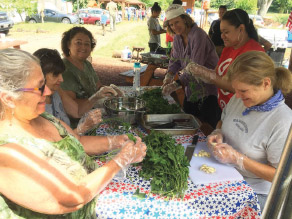
Volcano School of Arts and Sciences has made just that change, among others. “We’ve changed our playtime to where they can play before lunch instead of after,” confirms Amalie Dorn, who’s in charge of the school’s lunch program. The school has gone even farther than that: “In the lunchroom we play music for them to calm down. The students have five minutes of quiet eating time after they sit down so they can concentrate on eating.” Kids are allowed unlimited refills of fresh fruits or salads.
Ninety percent of the food comes fresh from local sources. The school has even replaced most wheat products with breadfruit (Amalie swears by the pizza dough made from breadfruit flour). The VSAS recipes are now being adopted by other area charter schools. The students also have cooking classes, so they can take those recipes home. The school is doing other things the Blue Zone way, as well. Lessons are “project-based” and “place-based,” so instead of sitting in the classroom, students are out moving around and building bonds with their community and environment.
With continued focus on the program, the students will take the lessons they have learned, and the healthy habits they have picked up, out into the community—to live long, healthy lives, and teach those habits to their own children. ❖
Contact Blue Zones Hawai‘i: hawaii.bluezonesproject.com.

